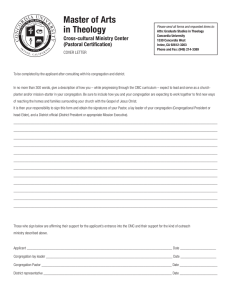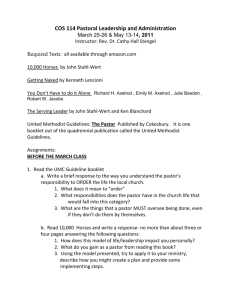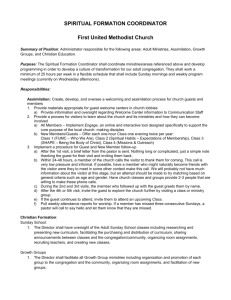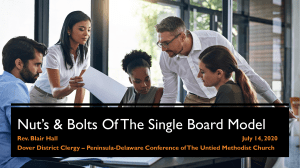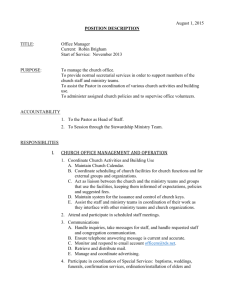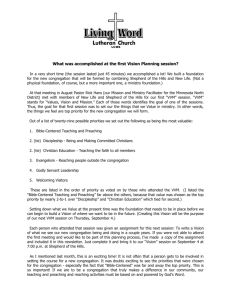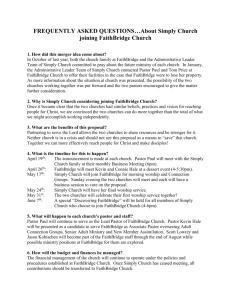Single Board Model: Church Leadership Guide
advertisement
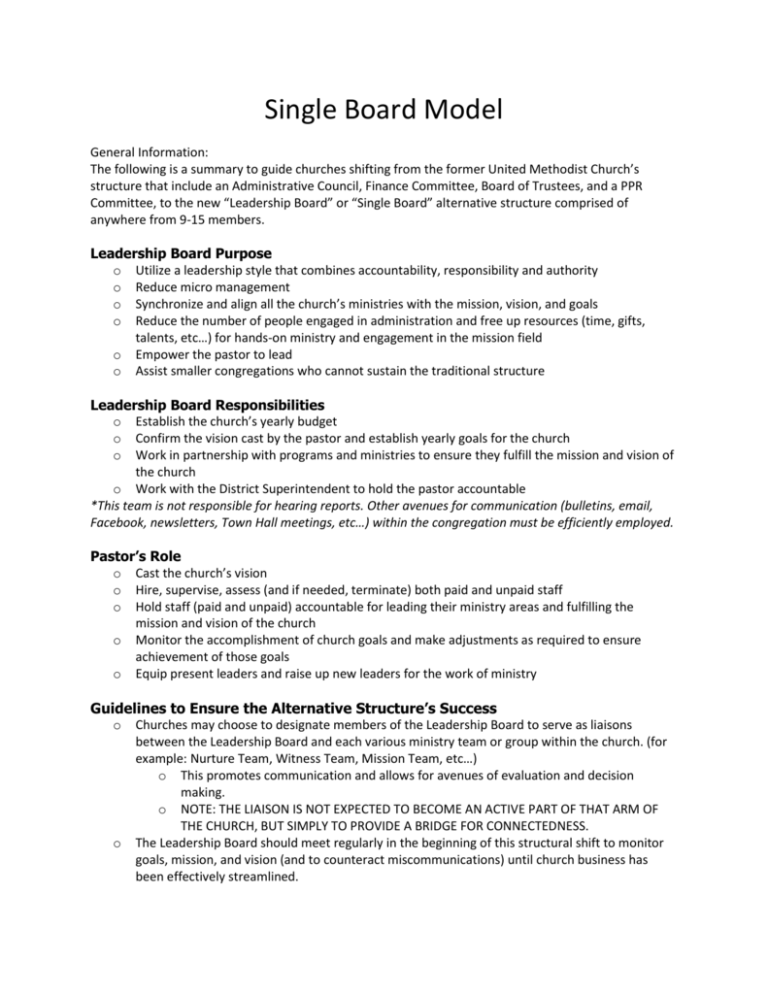
Single Board Model General Information: The following is a summary to guide churches shifting from the former United Methodist Church’s structure that include an Administrative Council, Finance Committee, Board of Trustees, and a PPR Committee, to the new “Leadership Board” or “Single Board” alternative structure comprised of anywhere from 9-15 members. Leadership Board Purpose o Utilize a leadership style that combines accountability, responsibility and authority o Reduce micro management o Synchronize and align all the church’s ministries with the mission, vision, and goals o Reduce the number of people engaged in administration and free up resources (time, gifts, talents, etc…) for hands-on ministry and engagement in the mission field o Empower the pastor to lead o Assist smaller congregations who cannot sustain the traditional structure Leadership Board Responsibilities o Establish the church’s yearly budget o Confirm the vision cast by the pastor and establish yearly goals for the church o Work in partnership with programs and ministries to ensure they fulfill the mission and vision of the church o Work with the District Superintendent to hold the pastor accountable *This team is not responsible for hearing reports. Other avenues for communication (bulletins, email, Facebook, newsletters, Town Hall meetings, etc…) within the congregation must be efficiently employed. Pastor’s Role o Cast the church’s vision o Hire, supervise, assess (and if needed, terminate) both paid and unpaid staff o Hold staff (paid and unpaid) accountable for leading their ministry areas and fulfilling the mission and vision of the church o Monitor the accomplishment of church goals and make adjustments as required to ensure achievement of those goals o Equip present leaders and raise up new leaders for the work of ministry Guidelines to Ensure the Alternative Structure’s Success o Churches may choose to designate members of the Leadership Board to serve as liaisons between the Leadership Board and each various ministry team or group within the church. (for example: Nurture Team, Witness Team, Mission Team, etc…) o This promotes communication and allows for avenues of evaluation and decision making. o NOTE: THE LIAISON IS NOT EXPECTED TO BECOME AN ACTIVE PART OF THAT ARM OF THE CHURCH, BUT SIMPLY TO PROVIDE A BRIDGE FOR CONNECTEDNESS. o The Leadership Board should meet regularly in the beginning of this structural shift to monitor goals, mission, and vision (and to counteract miscommunications) until church business has been effectively streamlined. o o o o o o The Leadership Board may conduct 2-4 Town Hall meetings a year or issue a “State of the Church” report in conjunction with the annual Charge Conference. When making significant decisions for the entire congregation, the Leadership Board may solicit input from the congregation. o It is best to offer the congregation 2-3 acceptable solutions/choices (which have already been thought out and perfected) to maximize success. It is recommended that the Leadership Board members rotate off after their term, to eliminate small circles of power and promote the development of new leaders. It is highly recommended that in the fall of each year, all groups and teams within the church draft their budget requests for the following year, along with 3 goals for the new year. o Including an explanation of how those goals fit the overall mission and vision of the church and a report on how goals were accomplished the previous year. Once the budget is approved, the pastor, staff, teams, and groups automatically have permission to spend the money they have requested, after communication occurs between the Treasurer and at least one Finance representative on the Leadership Board. o This ensures that funds are available before funds are spent. o The Leadership Board may also establish a spending cap (for example: any purchase under $300 is permissible without requiring communication with the Treasurer/Finance representative.) o Every Leadership Board member is not required to vote on every expenditure. o In a case when a team or group wishes to spend money for an item not already in the budget, the issue is taken to the Leadership Board. Once the Leadership Board is in place, the role of the Vision Team and Leadership Team (or other teams formed for the purpose of facilitating the HCI process) may be dissolved and absorbed into the new Leadership Board – unless the HCI prescriptions require their continuation.

